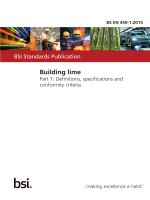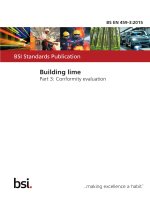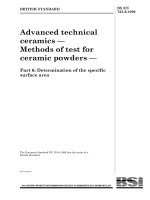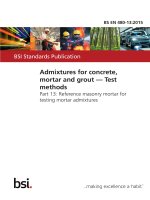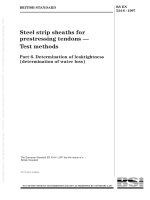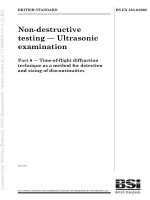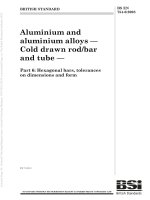Bsi bs en 62087 6 2015
Bạn đang xem bản rút gọn của tài liệu. Xem và tải ngay bản đầy đủ của tài liệu tại đây (1.25 MB, 28 trang )
BS EN 62087-6:2015
BSI Standards Publication
Audio, video and related
equipment — Determination
of power consumption
Part 6: Audio equipment
BRITISH STANDARD
BS EN 62087-6:2015
National foreword
This British Standard is the UK implementation of EN 62087-6:2015. It is
identical to IEC 62087-6:2015. Together with BS EN 62087-1, BS EN
62087-2, BS EN 62087-3, BS EN 62087-4 and BS EN 62087-5 it supersedes
BS EN 62087:2012 which will be withdrawn on 10 July 2018.
The UK participation in its preparation was entrusted to Technical
Committee EPL/100, Audio, video and multimedia systems and equipment.
A list of organizations represented on this committee can be obtained on
request to its secretary.
This publication does not purport to include all the necessary provisions of
a contract. Users are responsible for its correct application.
© The British Standards Institution 2015.
Published by BSI Standards Limited 2015
ISBN 978 0 580 82958 1
ICS 33.160.10
Compliance with a British Standard cannot confer immunity from
legal obligations.
This British Standard was published under the authority of the
Standards Policy and Strategy Committee on 30 September 2015.
Amendments/corrigenda issued since publication
Date
Text affected
BS EN 62087-6:2015
EUROPEAN STANDARD
EN 62087-6
NORME EUROPÉENNE
EUROPÄISCHE NORM
September 2015
ICS 33.160.10
Supersedes EN 62087:2012 (partially)
English Version
Audio, video and related equipment - Determination of power
consumption - Part 6: Audio equipment
(IEC 62087-6:2015)
Matériels audio, vidéo et matériel connexe - Détermination
de la consommation de puissance - Partie 6 : Matériel audio
(IEC 62087-6:2015)
Messverfahren für die Leistungsaufnahme von Audio-,
Video- und verwandten Geräten - Teil 6: Audiogeräte
(IEC 62087-6:2015)
This European Standard was approved by CENELEC on 2015-07-10. CENELEC members are bound to comply with the CEN/CENELEC
Internal Regulations which stipulate the conditions for giving this European Standard the status of a national standard without any alteration.
Up-to-date lists and bibliographical references concerning such national standards may be obtained on application to the CEN-CENELEC
Management Centre or to any CENELEC member.
This European Standard exists in three official versions (English, French, German). A version in any other language made by translation
under the responsibility of a CENELEC member into its own language and notified to the CEN-CENELEC Management Centre has the
same status as the official versions.
CENELEC members are the national electrotechnical committees of Austria, Belgium, Bulgaria, Croatia, Cyprus, the Czech Republic,
Denmark, Estonia, Finland, Former Yugoslav Republic of Macedonia, France, Germany, Greece, Hungary, Iceland, Ireland, Italy, Latvia,
Lithuania, Luxembourg, Malta, the Netherlands, Norway, Poland, Portugal, Romania, Slovakia, Slovenia, Spain, Sweden, Switzerland,
Turkey and the United Kingdom.
European Committee for Electrotechnical Standardization
Comité Européen de Normalisation Electrotechnique
Europäisches Komitee für Elektrotechnische Normung
CEN-CENELEC Management Centre: Avenue Marnix 17, B-1000 Brussels
© 2015 CENELEC All rights of exploitation in any form and by any means reserved worldwide for CENELEC Members.
Ref. No. EN 62087-6:2015 E
BS EN 62087-6:2015
EN 62087-6:2015
European foreword
The text of document 100/2471/FDIS, future edition 1 of IEC 62087-6, prepared by Technical Area 12
"AV energy efficiency and smart grid applications" of IEC/TC 100 "Audio, video and multimedia
systems and equipment" was submitted to the IEC-CENELEC parallel vote and approved by
CENELEC as EN 62087-6:2015.
The following dates are fixed:
•
latest date by which the document has to be
implemented at national level by
publication of an identical national
standard or by endorsement
(dop)
2016-04-10
•
latest date by which the national
standards conflicting with the
document have to be withdrawn
(dow)
2018-07-10
This document supersedes EN 62087:2012 (partially).
Attention is drawn to the possibility that some of the elements of this document may be the subject of
patent rights. CENELEC [and/or CEN] shall not be held responsible for identifying any or all such
patent rights.
Endorsement notice
The text of the International Standard IEC 62087-6:2015 was approved by CENELEC as a European
Standard without any modification.
In the official version, for Bibliography, the following notes have to be added for the standards indicated:
2
IEC 60065:2014
NOTE
Harmonized as EN 60065:2014 (modified).
IEC 60268-1:1985+A1:1988
NOTE
Harmonized as HD 483.1 S2:1989 (not modified).
IEC 60268-2:1987+A1:1991
NOTE
Harmonized as HD 483.2 S2:1993 (not modified).
IEC 60268-3:2013
NOTE
Harmonized as EN 60268-3:2013 (not modified).
IEC 60958-1:2008
NOTE
Harmonized as EN 60958-1:2008 (not modified).
IEC 60958-1:2008/A1:2014
NOTE
Harmonized as EN 60958-1:2008/A1:2014 (not modified).
IEC 61672 Series
NOTE
Harmonized as EN 61672 Series.
IEC 61938:2013
NOTE
Harmonized as EN 61938:2013 (not modified).
IEC 62087 Series
NOTE
Harmonized as EN 62087 Series.
IEC 62301:2011
NOTE
Harmonized as EN 50564:2011 (modified).
IEC 62368-1:2014
NOTE
Harmonized as EN 62368-1:2014 (modified).
IEC 62542:2013
NOTE
Harmonized as EN 62542:2013 (modified).
BS EN 62087-6:2015
EN 62087-6:2015
Annex ZA
(normative)
Normative references to international publications
with their corresponding European publications
The following documents, in whole or in part, are normatively referenced in this document and are
indispensable for its application. For dated references, only the edition cited applies. For undated
references, the latest edition of the referenced document (including any amendments) applies.
NOTE 1 When an International Publication has been modified by common modifications, indicated by (mod), the relevant
EN/HD applies.
NOTE 2 Up-to-date information on the latest versions of the European Standards listed in this annex is available here:
www.cenelec.eu
Publication
Year
Title
EN/HD
Year
IEC 60268-5
2003
Sound system equipment Part 5: Loudspeakers
EN 60268-5
2003
+A1
2007
+A1
2009
IEC 62087-1
2015
Audio, video, and related equipment Determination of power consumption Part 1: General
EN 62087-1
1)
-
IEC 62087-2
2015
Audio, video, and related equipment Determination of power consumption Part 2: Signals and media
EN 62087-2
2)
-
IEC 62301 (mod)
2011
Household electrical appliances Measurement of standby power
EN 50564
1)
2)
2011
At draft stage.
To be published.
3
–2–
BS EN 62087-6:2015
IEC 62087-6:2015 © IEC 2015
CONTENTS
FOREWORD ........................................................................................................................... 4
INTRODUCTION ..................................................................................................................... 6
1
Scope .............................................................................................................................. 7
2
Normative references ...................................................................................................... 7
3
Terms, definitions and abbreviations ............................................................................... 7
3.1
Terms and definitions .............................................................................................. 7
3.2
Abbreviations .......................................................................................................... 9
4
Specification of operating modes and functions ............................................................... 9
5
Measurement conditions ................................................................................................ 10
5.1
General ................................................................................................................. 10
5.2
Power source ........................................................................................................ 11
5.3
Environmental conditions ...................................................................................... 11
5.4
Acoustical environment ......................................................................................... 11
5.5
Adjustment of controls .......................................................................................... 11
5.6
Power measurement instrument ............................................................................ 11
5.7
Signal generation .................................................................................................. 11
5.8
Quantities to be specified and their accuracy ........................................................ 11
5.9
Loading of terminals ............................................................................................. 11
5.10 Output level .......................................................................................................... 11
5.10.1
General ......................................................................................................... 11
5.10.2
Output level at 1 W ........................................................................................ 11
5.10.3
Output level at one-eighth of non-clipped power ............................................ 11
5.11 Sound level adjustments ....................................................................................... 12
5.12 Sound pressure level meter .................................................................................. 12
5.13 Additional functions ............................................................................................... 12
5.14 Operating modes .................................................................................................. 12
5.14.1
General ......................................................................................................... 12
5.14.2
On modes ...................................................................................................... 12
5.14.3
Partial On modes ........................................................................................... 12
5.14.4
Off mode ....................................................................................................... 13
5.14.5
Auto power down function .............................................................................. 13
6
Measurement procedure ................................................................................................ 13
6.1
Order of measurements ........................................................................................ 13
6.2
Setup .................................................................................................................... 14
6.2.1
General ......................................................................................................... 14
6.2.2
Audio equipment terminals and settings ......................................................... 15
6.2.3
Compact audio system including loudspeaker ................................................ 16
6.3
Power measurement ............................................................................................. 16
6.3.1
General ......................................................................................................... 16
6.3.2
Off and Partial On modes .............................................................................. 16
6.3.3
On modes ...................................................................................................... 17
6.3.4
Auto power down ........................................................................................... 18
Annex A (informative) Location for sound pressure test ....................................................... 19
A.1
A.2
General ................................................................................................................. 19
Example test locations .......................................................................................... 19
BS EN 62087-6:2015
IEC 62087-6:2015 © IEC 2015
–3–
Bibliography .......................................................................................................................... 21
Figure 1 – Order of measurements ........................................................................................ 14
Figure 2 – Separate components .......................................................................................... 14
Figure 3 – Audio systems (non separable components) ........................................................ 15
Figure 4 – Audio systems (separable conponents) ................................................................ 15
Figure 5 – Compact audio system including loudspeaker ...................................................... 15
Figure 6 – Auto power down function .................................................................................... 18
Figure A.1 – Top view ........................................................................................................... 19
Figure A.2 – Top and front view ............................................................................................ 20
Figure A.3 – Side view .......................................................................................................... 20
Table 1 – Operating modes and functions ............................................................................. 10
–4–
BS EN 62087-6:2015
IEC 62087-6:2015 © IEC 2015
INTERNATIONAL ELECTROTECHNICAL COMMISSION
____________
AUDIO, VIDEO AND RELATED EQUIPMENT –
DETERMINATION OF POWER CONSUMPTION –
Part 6: Audio equipment
FOREWORD
1) The International Electrotechnical Commission (IEC) is a worldwide organization for standardization comprising
all national electrotechnical committees (IEC National Committees). The object of IEC is to promote
international co-operation on all questions concerning standardization in the electrical and electronic fields. To
this end and in addition to other activities, IEC publishes International Standards, Technical Specifications,
Technical Reports, Publicly Available Specifications (PAS) and Guides (hereafter referred to as “IEC
Publication(s)”). Their preparation is entrusted to technical committees; any IEC National Committee interested
in the subject dealt with may participate in this preparatory work. International, governmental and nongovernmental organizations liaising with the IEC also participate in this preparation. IEC collaborates closely
with the International Organization for Standardization (ISO) in accordance with conditions determined by
agreement between the two organizations.
2) The formal decisions or agreements of IEC on technical matters express, as nearly as possible, an international
consensus of opinion on the relevant subjects since each technical committee has representation from all
interested IEC National Committees.
3) IEC Publications have the form of recommendations for international use and are accepted by IEC National
Committees in that sense. While all reasonable efforts are made to ensure that the technical content of IEC
Publications is accurate, IEC cannot be held responsible for the way in which they are used or for any
misinterpretation by any end user.
4) In order to promote international uniformity, IEC National Committees undertake to apply IEC Publications
transparently to the maximum extent possible in their national and regional publications. Any divergence
between any IEC Publication and the corresponding national or regional publication shall be clearly indicated in
the latter.
5) IEC itself does not provide any attestation of conformity. Independent certification bodies provide conformity
assessment services and, in some areas, access to IEC marks of conformity. IEC is not responsible for any
services carried out by independent certification bodies.
6) All users should ensure that they have the latest edition of this publication.
7) No liability shall attach to IEC or its directors, employees, servants or agents including individual experts and
members of its technical committees and IEC National Committees for any personal injury, property damage or
other damage of any nature whatsoever, whether direct or indirect, or for costs (including legal fees) and
expenses arising out of the publication, use of, or reliance upon, this IEC Publication or any other IEC
Publications.
8) Attention is drawn to the Normative references cited in this publication. Use of the referenced publications is
indispensable for the correct application of this publication.
9) Attention is drawn to the possibility that some of the elements of this IEC Publication may be the subject of
patent rights. IEC shall not be held responsible for identifying any or all such patent rights.
International Standard IEC 62087-6 has been prepared by technical area 12: AV energy
efficiency and smart grid applications, of IEC technical committee 100: Audio, video and
multimedia systems and equipment.
This first edition of IEC 62087-6 cancels and replaces Clause 9 of IEC 62087:2011. This
standard together with IEC 62087-1 to IEC 62087-5 cancels and replaces IEC 62087:2011.
This International Standard constitutes a technical revision.
This edition includes the following significant technical changes with respect to Clause 9 of
IEC 62087:2011.
–
The definition of the input signal is changed.
–
The output power measurement of amplifiers is changed.
–
The measurement method for compact audio systems including loudspeakers is added.
BS EN 62087-6:2015
IEC 62087-6:2015 © IEC 2015
–5–
–
Methods for measuring On-decoding, idle and auto power down functions are added.
–
Portions of the document related to general measuring conditions and procedures are now
contained in IEC 62087-1:2015.
–
Portions of the document related to signals and media are now in IEC 62087-2:2015.
–
The titles have changed in order to comply with the current directives and to accommodate
the new multipart structure of IEC 62087.
The text of this standard is based on the following documents:
FDIS
Report on voting
100/2471/FDIS
100/2501/RVD
Full information on the voting for the approval of this standard can be found in the report on
voting indicated in the above table.
A list of all parts in the IEC 62087 series, published under the general title Audio, video, and
related equipment – Determination of power consumption, can be found on the IEC website.
This publication has been drafted in accordance with the ISO/IEC Directives, Part 2.
The committee has decided that the contents of this publication will remain unchanged until
the stability date indicated on the IEC website under "" in the data
related to the specific publication. At this date, the publication will be
•
reconfirmed,
•
withdrawn,
•
replaced by a revised edition, or
•
amended.
A bilingual version of this publication may be issued at a later date.
–6–
BS EN 62087-6:2015
IEC 62087-6:2015 © IEC 2015
INTRODUCTION
This part of IEC 62087 specifies methods of measurements for the power consumption of
audio equipment for consumer use. It is used in conjunction with IEC 62087-2, which specifies
signals and media. This International Standard includes measurements in the On mode
(operation), which was previously identified as “On (average) mode” and adds methods for
measuring power consumption in the On-play, On-decoding, and idle sub-modes. These
methods consider the effects of the auto power down function. Additionally, this standard
includes determination of power consumption in the Partial On mode.
This standard has been divided into multiple parts. At the time of publication of this part, the
following parts are planned or published.
–
Part 1: General
–
Part 2: Signals and media
–
Part 3: Television sets
–
Part 4: Video recording equipment
–
Part 5: Set-top boxes (STB)
–
Part 6: Audio equipment
BS EN 62087-6:2015
IEC 62087-6:2015 © IEC 2015
–7–
AUDIO, VIDEO AND RELATED EQUIPMENT –
DETERMINATION OF POWER CONSUMPTION –
Part 6: Audio equipment
1
Scope
This part of IEC 62087 specifies the determination of the power consumption of audio
equipment for consumer use.
The various modes of operation which are relevant for measuring power consumption are
defined.
This standard is limited to audio equipment which can be connected to the mains. Audio
equipment that includes a non-removable, main battery is not covered by this standard. Audio
equipment may include any number of auxiliary batteries.
The measuring conditions in this standard represent the normal use of the equipment and
may differ from other specific conditions, for example as specified in safety standards.
2
Normative references
The following documents, in whole or in part, are normatively referenced in this document and
are indispensable for its application. For dated references, only the edition cited applies. For
undated references, the latest edition of the referenced document (including any
amendments) applies.
IEC 60268-5:2003, Sound system equipment – Part 5: Loudspeakers
IEC 60268-5:2003/AMD1:2007
IEC 62087-1:2015, Audio, video,
consumption – Part 1: General
and
related
equipment
–
Determination
of
power
IEC 62087-2:2015, Audio, video, and
consumption – Part 2: Signals and media
related
equipment
–
Determination
of
power
IEC 62301:2011,
3
3.1
Household electrical appliances − Measurement of standby power
Terms, definitions and abbreviations
Terms and definitions
For the purposes of this document, the terms and definitions in IEC 62087-1:2015,
IEC 62087-2:2015, and the following apply.
3.1.1
additional functions
functions that are not required for the basic operation of the device
Note 1 to entry:
Functions other than a main function.
–8–
BS EN 62087-6:2015
IEC 62087-6:2015 © IEC 2015
3.1.2
audio equipment
appliance which has the main function of reproducing analogue and/or digital audio signals
3.1.3
audio systems
audio equipment of separable or non-separable components for one or more audio functions
3.1.4
compact audio systems including loudspeakers
amplifier and one or more audio sources in a single enclosure, which might also contain the
loudspeakers
Note 1 to entry:
The loudspeakers can be attached to, and separable from, the main enclosure.
3.1.5
free-field conditions
environment, such as an anechoic room, in which the sound pressure decreases by a factor of
2 with the doubling of the distance from a point source
3.1.6
main function
function, specified by the manufacturer, which produces sound from loudspeaker(s) and/or
output terminal(s)
3.1.7
mass storage device
non-removable, non-volatile storage for the recording of audio signals
3.1.8
multi-channel
two or more channels
3.1.9
non-clipped power
sine-wave power dissipated in the rated load impedance, measured at 1 000 Hz or the
frequency of the peak response, if the operation at 1 kHz is not intended, at the onset of
clipping at either one or both peaks
3.1.10
rated load impedance
impedance specified by the manufacturer and assumed to be a constant pure resistance
measured at the output terminals of an amplifier
3.1.11
separate components
standalone audio equipment that provides one or more audio functions
3.1.12
sound pressure level
SPL
logarithm of the ratio of a given sound pressure to the reference sound pressure
Note 1 to entry:
Unless otherwise specified, the reference sound pressure is 20 µPа for airborne sound.
Note 2 to entry:
square values.
Unless otherwise specified, the sound pressures are understood to be expressed in root-mean-
Note 3 to entry:
Sound pressure level in decibels is 20 times the logarithm to the base ten of the ratio.
BS EN 62087-6:2015
IEC 62087-6:2015 © IEC 2015
–9–
3.1.13
surround sound equipment
multi-channel audio equipment that includes front and rear channel capabilities
EXAMPLE
3.2
Home theatre in a box, integrated surround sound amplifier.
Abbreviations
′
Prime
PS
Power Supply unit
SPL
Sound Pressure Level
SW
Switch unit
UUT
Unit Under Test
4
Specification of operating modes and functions
Table 1 describes the various operating modes and functions for audio equipment.
For all modes, main batteries, if any, shall be removed for the duration of the measurement
procedure. (See IEC 62087-1:2015, 5.1.1.1)
– 10 –
BS EN 62087-6:2015
IEC 62087-6:2015 © IEC 2015
Table 1 – Operating modes and functions
Power
Mode
Sub-mode
Function(s)
Description
0W
Disconnected
Disconnected
– Disconnected from
the main power
source
The audio equipment is
disconnected or galvanically
isolated from all external power
sources.
≥0 W
Off
Off
– Off
The audio equipment is connected
to an external power source and
provides no functions that depend
on an external power source. The
equipment cannot be switched into
any other mode with the remote
control unit, or an external or
internal signal. Note that some
power may be consumed if an EMC
filter or other components exist on
the source side of the power switch.
≥0 W
Partial on
Standbypassive
– Wake on
Standbyactive, low
Standbyactive, high
•
remote control
•
internal signal
– Wake on
•
remote control
•
internal signal
•
external signal
– Wake on
•
remote control
•
internal signal
•
external signal
Data communications
>0 W
On
The audio equipment is connected
to an external power source and
does not provide its main functions.
The equipment can be switched into
another mode with the remote
control unit or an internal signal, but
not with an external signal.
The audio equipment is connected
to an external power source and
does not provide its main functions.
The equipment can be switched into
another mode with the remote
control unit, an internal signal, or an
external signal.
The audio equipment is connected
to an external power source and
does not provide its main functions.
The equipment can be switched into
another mode with the remote
control unit, an internal signal, or an
external signal. Additionally, the
equipment is exchanging/receiving
data with/from an external source.
Idle
Idle
Form of On mode during which the
equipment is capable of performing
its main function(s) but is not doing
so.
On-play
Operation
The audio equipment is performing
its main functions.
On-decoding
Operation
The audio equipment is decoding
compressed audio from a mass
storage device or external input.
On-record
Operation
The audio equipment is recording a
single programme and may or may
not provide the audio outputs of the
programme being recorded.
The terms 'standby mode' or 'sleep mode' also describe the Partial On mode.
5
5.1
Measurement conditions
General
The measurement conditions clause specifies requirements that are independent of the
equipment to be measured. When setting up a test laboratory, these requirements shall be
taken into account.
BS EN 62087-6:2015
IEC 62087-6:2015 © IEC 2015
– 11 –
The requirements in this clause apply to the measurement methods specified in Clause 6.
5.2
Power source
Defined in IEC 62087-1:2015, 5.1.1.
5.3
Environmental conditions
Defined in IEC 62087-1:2015, 5.1.2.
5.4
Acoustical environment
SPL measurements shall
IEC 60268-5:2003, 5.2.
5.5
be
made
under
the
free-field
conditions
specified
in
Adjustment of controls
The controls not specifically mentioned in this standard shall be in the position adjusted by
the manufacturer for shipment to the end user. These controls shall remain in this state for
the duration of the test.
5.6
Power measurement instrument
Defined in IEC 62087-1:2015, 5.1.1.
5.7
Signal generation
Defined in IEC 62087-2:2015, Clause 6.
5.8
Quantities to be specified and their accuracy
Unless otherwise stated, the values of voltage, current, sound pressure, etc., mentioned in
this standard are assumed to be r.m.s. quantities. For most purposes, it is sufficient to
measure electrical quantities with an accuracy of ± 0,15 dB and acoustical quantities with an
accuracy of ± 1 dB. Unless otherwise stated, it is assumed that the distance between a
measurement point and its reference point is determined with an accuracy of ±0,01 m. The
accuracy of measurement required depends only on the purpose for which the results are to
be used.
5.9
Loading of terminals
All loudspeaker terminals should be terminated with the minimum impedance as specified by
the manufacturer.
5.10
5.10.1
Output level
General
In the case of surround sound equipment, only the front left and front right speaker terminals
shall be loaded.
5.10.2
Output level at 1 W
The volume control shall be adjusted to obtain 1 W at the loudspeaker terminals.
5.10.3
Output level at one-eighth of non-clipped power
If the maximum non-clipped power is less than 8 W, the volume control shall be adjusted to
obtain one-eighth of non-clipped power at the loudspeaker terminals.
– 12 –
BS EN 62087-6:2015
IEC 62087-6:2015 © IEC 2015
Where the non-clipped power cannot be obtained using any audio test signal, the maximum
attainable output power is taken.
5.11
Sound level adjustments
The volume control shall be set to a level at which a SPL of 60 dB is measured 1 m from the
loudspeaker.
NOTE
An SPL of 60 dB is not necessarily the same output level as 1 W at the loudspeaker terminals.
5.12
Sound pressure level meter
Measurements in free-field condition shall be made using a sound pressure level meter
having a known calibration.
NOTE
Class 1 certified meter, specified in IEC 61672, with A-weighting, specified in IEC 60268-1.
5.13
Additional functions
Additional functions shall be turned off during the measurement process in the cases that
those functions can be turned on and off by the end user.
5.14
Operating modes
5.14.1
General
Audio equipment can operate in many modes.
5.14.2
On modes
5.14.2.1
On-play
The audio equipment is performing the main function.
5.14.2.2
On-decoding
The audio equipment is decoding compressed audio from a mass storage device or external
input.
5.14.2.3
Idle
A form of On mode during which the equipment is capable of performing its main function(s)
but is not doing so.
EXAMPLE 1
signal.
Audio equipment that is in “On-play” status, but does not currently provide an audio output sound
EXAMPLE 2
An optical disc player that is in “On-play” status, but is not currently playing a disc.
5.14.2.4
On-record
The audio equipment is recording a single programme and may or may not provide the audio
outputs of the programme being recorded.
5.14.3
5.14.3.1
Partial On modes
Standby-active, high
The audio equipment is placed in a mode where it
a) does not provide its main functions,
BS EN 62087-6:2015
IEC 62087-6:2015 © IEC 2015
– 13 –
b) can be switched into another mode with the remote control unit, an internal signal, or an
external signal,
c) exchanges/receives data with/from an external source.
The data exchanged with an external source may provide information for functions such as:
•
conditional access keys management,
•
firmware upgrade.
This mode may not be available in all audio equipment.
5.14.3.2
Standby-active, low
The audio equipment is placed in a mode where it
a) does not provide its main functions,
b) can be switched into another mode with an internal or external signal, and
c) does not exchange/receive data with/from an external source.
This mode may not be available in all audio equipment.
5.14.3.3
Standby-passive
The audio equipment is placed in a mode where it
a) does not provide its main functions, and
b) can only be switched into another mode with the remote control unit or an internal signal.
The audio equipment is performing no useful function other than monitoring for a command to
switch to another mode. This command could come from a remote control or an internal
signal.
This mode may not be available in all audio equipment.
5.14.4
Off mode
The audio equipment is connected to a power source, fulfills no function, and it cannot be
switched into any other mode with a remote control, an internal or an external signal.
This mode may not be available in all audio equipment.
5.14.5
Auto power down function
An auto power down feature may be implemented in audio equipment to power the equipment
down into a Partial On mode after a predetermined time. This feature is referred to as auto
power down.
6
6.1
Measurement procedure
Order of measurements
This document recommends the following order for the measurement procedure:
–
Setup
a) Power consumption measurement, Off mode
b) Power consumption measurement, Partial On mode
c) Power consumption measurement, Idle mode
BS EN 62087-6:2015
IEC 62087-6:2015 © IEC 2015
– 14 –
d) Power consumption measurement, On mode
e) Power consumption measurement, auto power down
The above order is chosen to ensure proper stabilization prior to taking of each measurement.
The technician performing the test may vary the order as needed. However, the stabilization
prior to the taking of each measurement shall effectively be the same as if the recommended
order had been followed. (See Figure 1.)
Start
Setup
a) Power consumption
measurement,
Off mode
b) Power consumption
measurement,
Partial On mode
c) Power consumption
measurement,
Idle mode
d) Power consumption
measurement,
On mode
e) Power consumption
measurement,
auto power down
End
IEC
Figure 1 – Order of measurements
6.2
6.2.1
Setup
General
The UUT should be set up in a manner to simulate a normal operating environment. Optional
peripheral devices shall not be connected to the UUT for the duration of the measurement
procedure.
Main batteries, if any, shall be removed from UUT for the duration of the measurement
procedure.
Possible configurations of audio equipment connected to the mains are shown in Figure 2,
Figure 3, Figure 4 and Figure 5.
PS
Mains
IEC
Figure 2 – Separate components
BS EN 62087-6:2015
IEC 62087-6:2015 © IEC 2015
– 15 –
Subunit (Player for optical discs)
Subunit (Broadcast radio receiver)
Main unit (Amplifier)
PS
AC/DC
coupled
Mains
IEC
Figure 3 – Audio systems (non separable components)
Subunit (Player for optical discs)
Subunit (Broadcast radio receiver)
Main unit (Amplifier)
PS
PS
PS
AC coupled at the
rated mains voltage
Mains
SW
SW: operated by the partial on control unit
Each unit may be assessed independently.
IEC
Figure 4 – Audio systems (separable conponents)
Player for optical discs
Loudspeaker
Broadcast radio receiver
Amplifier
Loudspeaker
PS
AC coupled at the
rated mains voltage
Mains
IEC
Figure 5 – Compact audio system including loudspeaker
6.2.2
Audio equipment terminals and settings
The output terminals of the UUT, if any, shall be terminated with the rated load impedance.
The terminals which are not used during the measurement shall be terminated, if necessary,
as specified by the manufacturer. In the case of equipment with surround sound capabilities,
only the front L and front R speaker terminals shall be loaded.
The settings of the UUT shall be as follows.
a) The tone controls, if any, shall be set to the nominal or neutral position to provide the
frequency response as specified by the manufacturer.
NOTE 1
This is typically flat frequency response.
b) The balance control(s), if any, shall be set to the mechanical central position.
c) The surround sound function, if any, shall be set to a neutral setting that does not alter the
frequency response or add delay to the channels, if such a setting is available. If not
available, the default setting shall be used.
NOTE 2
The neutral setting is often labelled “stereo”.
d) If the UUT has video output(s), it shall be set to provide a video output signal.
A sine wave signal (IEC 62087-2: 2015, 4.3.1) shall be connected to the audio input terminals
of the UUT. If the UUT does not have any input terminals, the signal may be provided via an
RF audio signal input or reproduced from tape, disc or mass storage device.
BS EN 62087-6:2015
IEC 62087-6:2015 © IEC 2015
– 16 –
6.2.3
Compact audio system including loudspeaker
If the UUT is a compact audio system that includes an internal loudspeaker that cannot be
replaced by the rated load impedance, then the sound pressure level may be measured as
follows.
a) The UUT shall be set up in an anechoic environment.
b) The SPL is measured 1 m from the loud speaker by a sound level meter.
EXAMPLE
A possible UUT location is shown in Annex A.
c) The simulated programme signal according to IEC 62087-2:2015, 4.3.1.2 shall be used as
test signal.
d) The tone controls, if any, shall be set to the nominal or neutral position to provide the
frequency response as specified by the manufacturer.
NOTE 1
This is typically a flat frequency response.
e) The balance control(s), if any, shall be set to the mechanical central position.
f)
The surround sound function, if any, shall be set to a neutral setting that does not alter the
frequency response or add delay to the channels, if such a setting is available. If not
available, the default setting shall be used.
NOTE 2
The neutral setting is often labelled “stereo”.
g) If the UUT has video output(s), it shall be set to provide a video output signal.
A sine wave signal (IEC 62087-2:2015, 4.3.1.1) shall be connected to the audio input
terminals of the UUT. If the UUT does not have any input terminals, the signal may be
provided via an RF audio signal input or reproduced from a tape, disc, or mass storage device.
The test report shall indicate which method was used for the power measurement.
6.3
Power measurement
6.3.1
General
The audio equipment under test shall be measured in each applicable mode as specified
below.
6.3.2
6.3.2.1
Off and Partial On modes
General
Power consumption in the off and standby-passive sub-mode shall be measured as specified
in IEC 62301:2011. If the audio equipment supports the standby-active, low and standbyactive, high sub-modes, power consumption in those sub-modes may also be measured using
IEC 62301:2011.
6.3.2.2
Off
Power consumption
IEC 62087-1:2015.
6.3.2.3
in
the
Off
mode
(P OFF )
shall
be
measured
as
specified
in
Standby-active, high
If possible, activate a download mode from the primary service and measure the average
power consumed for at least 2 min. This measurement may require information from the
manufacturer and/or service provider to ensure the transport stream contains a suitable
download and instructions on how to set the audio equipment to receive the download. Report
this value as P SAH . Report the time used to measure the average power.
BS EN 62087-6:2015
IEC 62087-6:2015 © IEC 2015
– 17 –
NOTE It might not be possible to place the audio equipment into this mode. If this is the case and the value is still
required it could only be provided by manufacturer’s declaration.
6.3.2.4
Standby-active, low
To ensure that the audio equipment is in standby-active, low and is not performing any
downloading or recording functions, the following procedure should be used:
a) put the audio equipment into On mode;
b) after 5 min in On mode, press the standby or off button on the remote control;
c) stabilize the audio equipment for 30 min or until higher power mode maintenance activities
within the UUT have been completed.
Measure the average power consumed for at least 2 min. Report this as P SAL . Report the time
used to measure the average power. Report the time taken to switch to standby-active, low.
6.3.2.5
Standby-passive
To ensure that the audio equipment is in the standby-passive sub-mode, the following
procedure should be used:
a) put the audio equipment into the On mode;
b) after 5 min in this mode, press the standby or off button on the remote control;
c) stabilize the audio equipment for 30 min or until higher power mode maintenance activities
within the UUT activities have been completed.
Measure the average power consumed for at least 2 min. Report this as P SP . Report the time
used to measure the average power. Report the time taken to switch to standby-passive.
6.3.3
6.3.3.1
6.3.3.1.1
On modes
On-play
Measurement of the power consumption during reproduction of the test
signal to the loudspeaker terminals
With the UUT providing the test signal to the loudspeaker terminals, measure the average
power consumed for at least 2 min. Report this as P ON . Report the time used to measure the
average power.
6.3.3.1.2
Measurement for compact audio system including loudspeaker
With the UUT playing the simulated programme signal, measure the average power consumed
for at least 2 min. Report this as P SPL_ON . Report the time used to measure the average
power.
6.3.3.1.3
Measurement for audio equipment without amplifier
With the UUT playing back a previously recorded programme, measure the average power
consumed for at least 2 min. Report this as P PL . Report the time used to measure the average
power.
6.3.3.2
On-decoding
With the UUT playing back a previously recorded programme from a compressed audio
format, measure the average power consumed for at least 2 min. Report this as P AV_ON .
Report the time used to measure the decoding power.
– 18 –
6.3.3.3
BS EN 62087-6:2015
IEC 62087-6:2015 © IEC 2015
Idle
The UUT shall be set in the On mode with its volume control adjusted to the minimum setting
such that the unit does not provide any audio output. The UUT shall be set in such a manner
that it does not perform any other function. With the UUT in this condition, measure the
average power consumed for at least 2 min. Report this as P IDLE . Report the time used to
measure the average power.
6.3.3.4
On-record
Start or schedule a recording. With the UUT recording the simulated programme signal
according to IEC 62087-2, measure the average power consumed for at least 2 min. Report
this as P REC_ON . Report the time used to measure the average power.
6.3.4
Auto power down
If the UUT includes an auto power down feature, use the following procedure to determine the
auto power down interval and the power consumption after auto power down is completed.
(See Figure 6.)
a) Place the UUT in the On mode with the auto power down function enabled. The auto
power down interval is specified by the manufacturer. The auto power down interval
should be reported.
b) Stop any main functions of the UUT and start a timer to determine the auto power down
interval.
c) Allow the UUT to automatically power down.
d) Monitor the power consumption of the UUT until the power consumption stabilizes.
e) Stop the timer and report the auto power down interval.
Measure the average power consumed for a two minute period. Report this as P APD .
Power consumption
f)
Auto power down function
Auto power down interval
(determined by the manufacturer)
On mode
power consumption
Possible maintenance
functions in progress
Auto power down
power consumption
Stop any main
functions
Auto power
down starts
Auto power
down completed
Elapsed time
IEC
Figure 6 – Auto power down function
BS EN 62087-6:2015
IEC 62087-6:2015 © IEC 2015
– 19 –
Annex A
(informative)
Location for sound pressure test
A.1
General
Measurement location (sound meter placement): 1 m in front of the primary sound radiating
surface plane of unit under test.
A.2
Example test locations
Figure A.1 shows a possible test location for the loudspeaker of the UUT and the sound meter.
Top view: Product sitting on the ground reference
Determination of measurement
reference plane relative to primary
sound radiating surface for various
housing shapes
UUT shape
Convex front
UUT shape
Concave front
UUT shape
Rectangular
shape
Centered
1m
Sound meter
microphone
Reference axis
Centered
1m
Sound meter
microphone
Reference axis
Centered
1m
Sound meter
microphone
Reference axis
Example:
mini-component
system with
separable speakers
IEC
Figure A.1 – Top view
Figure A.2 and Figure A.3 show possible configurations and placements of the sound meter
for UUTs of various shapes.
– 20 –
BS EN 62087-6:2015
IEC 62087-6:2015 © IEC 2015
Front view
Top view
UUT shape
Convex front
Target microphone of sound meter
‘dead center’ to primary sound
radiating surface
UUT shape
Concave front
UUT shape
Rectangular
shape
Example:
mini-component
system with
separable speakers
Reference plane
IEC
Figure A.2 – Top and front view
Side view
For a product where the primary sound radiating
surface is tilted.
Shim the UUT so it is square to the reference plane.
Centered
Shim
1m
Sound meter
microphone
Reference axis
Reference plane:
Primary sound radiating
surface of product
IEC
Figure A.3 – Side view
BS EN 62087-6:2015
IEC 62087-6:2015 © IEC 2015
– 21 –
Bibliography
IEC 60050-801:1994,
and electroacoustics
International Electrotechnical Vocabulary − Chapter 801: Acoustics
IEC 60065:2014, Audio, video and similar electronic apparatus – Safety requirements
IEC 60268-1:1985, Sound system equipment – Part 1: General
IEC 60268-1:1985/AMD1:1988-01
IEC 60268-1:1985/AMD2:1988-06
IEC 60268-2:1987, Sound system equipment – Part 2: Explanation of general terms and
calculation methods
IEC 60268-2:1987/AMD1:1991
IEC 60268-3:2013,
Sound system equipment – Part 3: Amplifiers
IEC 60958-1:2008, Digital audio interface – Part 1: General
IEC 60958-1:2008/AMD1:2014
IEC 60958-3:2006, Digital audio interface – Part 3: Consumer applications
IEC 60958-3:2006/AMD1:2009
IEC 61672 (all parts),
Electroacoustics − Sound level meters
IEC 61938:2013, Multimedia systems – Guide to the recommended characteristics of
analogue interfaces to achieve interoperability
IEC 62087 (all parts),
consumption
IEC 62301:2011,
Audio, video, and related equipment – Determination of power
Household electrical appliances – Measurement of standby power
IEC 62368-1:2014, Audio/video, information and communication technology equipment –
Part 1: Safety requirements
IEC 62542:2013, Environmental standardization for electrical and electronic products and
systems – Glossary of terms
FEDERAL TRADE COMMISION 16 CFR Part 432, Trade Regulation Rule Relating to Power
Output Claims for Amplifiers Utilized in Home Entertainment Products
ENERGY STAR ®
Program Requirements for Audio/Video
____________

